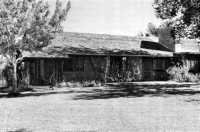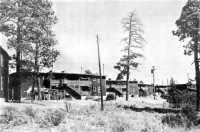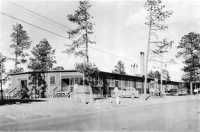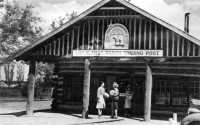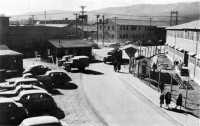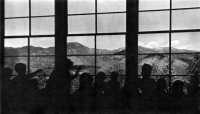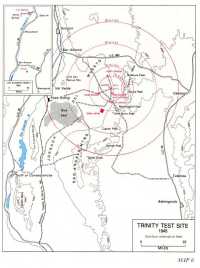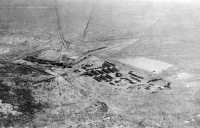Chapter 23: The Atomic Communities in New Mexico
Manhattan Project leaders’ choice of isolated and remote sections of central New Mexico for developing and testing the atomic bomb transformed two hitherto sparsely populated regions into two unique scientific communities. Some 20 miles west of the famous Santa Fe Trail, the rugged Pajarito Plateau became the site of the Los Alamos reservation, the operating community comprising the bomb development laboratory with technical installations and a residential area; and some 160 miles south of Los Alamos, the desolate Jornada del Muerto valley provided the location for the Trinity base camp, the temporary community comprising a bomb test area with technical facilities and a campsite. Because of the geographic inaccessibility and arid climate of these regions, few of the thousands of persons who came into the Southwest – either over the trail or the railroad that replaced it – chose to settle there, further enhancing their suitability for the highly secret activities of the bomb development project.1
Los Alamos: The Operating Community
With the often snow-capped peaks of the Sangre de Cristo Mountains looming in the distance, the broad expanse of the Pajarito Plateau extended westward from an altitude of 7,300 feet at Los Alamos to the heavily wooded slopes of the 9,000-foot Jemez Mountains and eastward to the wide Rio Grande valley. Bypassed by the mainstream of settlement and development, there were only a few scattered ranches on the great plateau by the early years of the twentieth century. Of these ranches, the one situated atop the Los Alamos mesa – locally referred to as the Hill – attracted the interest of two different purchasers, each with a different objective. In 1917, to realize a long-standing dream, former Detroit businessman Ashley Pond had bought the ranch as the location for his Los Alamos Ranch School for Boys. A quarter of a century
later, to meet Manhattan Project goals, the Army acquired this same ranch as the location for one of its atomic reservations.2 (See Map 5.)
Planning
On a wintry day in early’ November 1942, a small group of Army engineer officers visited the Los Alamos Ranch School. Of the several possible sites they had examined, this one impressed them most as nearly meeting all their criteria for security, safety’, ease of acquisition, and conversion into a scientific research and development community. There was a large enough area cleared of timber to permit an immediate start on the erection of technical structures and the buildings of the school would provide more than sufficient housing for the relatively small group of scientists who would staff the bomb laboratory. Following Groves and Oppenheimer’s inspection and approval a Few days later, the War Department notified the owners of the school that the government was starting condemnation proceedings to acquire the property and that they had until mid-February 1943 to vacate, time enough for members of the small student body to complete their academic studies for the year.3
Weeks before the students finally departed from the Hill, plans to secure a construction contractor and, as Stone and Webster’s replacement, a new architect-engineer for the Los Alamos community development program were already under way. The Albuquerque District surveyed construction firms in the region and, as the construction contractor, chose the M. M. Sundt Company of Tucson, Arizona, which was just completing a job for the Army at a camp near Las Vegas, New Mexico. The firm appeared attractive for the task not only because it had available nearby equipment and manpower but also because, unlike many construction companies, it had its own fleet of trucks and operated its own plumbing, electrical, and painting departments. This meant that Sundt would have to employ fewer subcontractors, a plus from the standpoint of project security.
When the Army signed its lump-sum contract with Sundt in mid-December, company representatives were already in Santa Fe securing office quarters and initiating procurement for workmen and building materials. These expeditious efforts permitted Sundt crews to begin clearing the site by the end of the month, when the Army also completed negotiations with Willard C. Kruger and Associates of Santa Fe to be the new architect-engineer. Kruger’s location near the newly established Santa Fe Engineers Office and the area office of the construction contractor facilitated the firm’s ability to cope promptly with changes and expansions in the community.4
bTypical building at the Los Alamos Ranch School for Boys
Kruger used Stone and Webster’s original plans for Los Alamos, which incorporated the ideas and specifications of Oppenheimer and other project scientists, as the basis of its initial blueprints for the community. In these early plans, drawn up in late 1942 and approved by the prime contractor, the University of California, the fifty-four school buildings formed the nucleus of the community, with the new houses, dormitories, barracks, service, and other buildings of the nontechnical area located to the northeast and with the installations of the technical area, enclosed by a high chain link fence, located to the south along the precipitous rim of Jemez Canyon. But these early plans constituted only a rudimentary beginning for construction on the Hill. Further planning in early 1943 by Groves and scientific leaders of the project, especially Oppenheimer and James B. Conant, revealed that the bomb development program was going to be a far larger enterprise than originally anticipated and that precise answers to questions concerning the size of the laboratory, its staff, technical facilities, and supporting community would become available only after a great deal more study and research.5
As at Clinton and Hanford, there was the same urgency at Los Alamos to complete facilities in the shortest possible time and at the lowest cost in terms of manpower and critical materials. Hence, wherever feasible, design and layout procedures were streamlined. On nontechnical community structures (housing, service, and recreational buildings), the Albuquerque District submitted requirements directly to Kruger without going through the University of California. Kruger then outlined the job specifications to each subcontractor, who in turn provided a cost estimate. Once Kruger and the subcontractor had agreed on a reasonable cost, the proposal was submitted in the form of a lump-sum contract to the Albuquerque District. The latter office reviewed the document and calculated the profit made, and if this appeared excessive, it required the subcontractor to return the overage.6
Plans for the New Mexico establishment followed the general pattern of those for Clinton and Hanford: highly tentative and subject to repeated and drastic vicissitudes. Nevertheless, on one project requirement – that of security – Manhattan remained vigilantly uncompromising. Because the need for secrecy was so crucial, Los Alamos, unlike Clinton and Hanford, was planned as a military post, with a military commander and staff and various military units to perform post engineer and security functions. For the same reason, project planners decided to provide on-site accommodations and community services (commissary, medical care, and recreation) for all military personnel and civilian scientists and technicians, and, in many’ cases, their families as well, because of their respective post functions and secret job assignments. As nontechnical civilian employees working in unclassified jobs did not pose a security risk, Manhattan recommended that they reside in the neighboring small towns and use Army bus transportation to commute to and from the job. They would, however, have access to on-site housing based on its availability and their family need.7
Construction and Operation
Because of the unpredictable expansion in the size of the bomb development program, community construction tended to be an open-ended process, with each new influx of civilian and military personnel requiring additional facilities. Housing constituted by far the largest part of community construction, reflecting a rapidly expanding population. From an estimated fifteen hundred persons in January 1943, comprised mostly of Sundt construction employees, the population increased to almost thirty-five hundred a year later, although most Sundt personnel had departed, and approached fifty-seven hundred at the beginning of 1945.8
With the completion of the first major phase of community construction in the fall of 1943, the Sundt Company withdrew its personnel and equipment from the site and the post commander prepared to take over primary responsibility for community maintenance as well as any further minor construction. General Groves had been concerned about having an outside contractor and the Albuquerque District involved in the bomb program and he now took steps to tighten security. In early 1944, the Manhattan District assumed full responsibility for supervising all further construction. Lt. Col. Whitney Ashbridge, the post commander, recruited additional carpenters, plumbers, and other workers and assigned them to the Operations Division, which he reorganized into two sections: one for community maintenance and construction, the other for technical area work. Work crews from the division, often comprised of both civilians and enlisted men from the Provisional Engineer Detachment (PED), undertook many minor construction jobs ordinarily carried out by construction contractors.
Division crews, however, could not handle all the work, and occasionally outside contractors were brought in through the Albuquerque District. An increase in the number of outside contractors employed by Manhattan occurred in March 1944, when both the technical and community facilities had to be expanded substantially. The Army once again had to risk calling upon the Albuquerque District to begin a search for additional contractors. This time two El Paso, Texas, firms were chosen: J. E. Morgan and Sons, to install prefabricated apartment buildings; and Robert E. McKee, to undertake the new phase of technical construction.9
The unpredictable expansion of the bomb program consistently outran available housing. With on-site housing still under construction in the spring of 1943, the first laboratory staff members had to stay at guest ranches in the vicinity of the Hill. By June, these accommodations were so overtaxed by the influx of technical personnel that the Army had to acquire the National-Park Service’s Frijoles Lodge in Bandelier National Monument, 14 miles south of Los Alamos. From June to October 1943 and again for a brief period in July-August 1944, overflow laboratory personnel resided at the Frijoles Canyon lodgings amid the ruins of ancient Indian dwellings. In 1944 and 1945, the unavailability of sufficient dormitory housing for married enlisted men of the Special Engineer Detachment (SED) and the strict enforcement of security regulations that forbade bringing wives to live in nearby civilian communities severely strained the morale of many junior scientists and technicians. The continuing shortage of family-type facilities resulted not only from the unexpectedly rapid increase in personnel and the wartime
Four-family apartment units at Los Alamos
limitations on labor and materials but also from the deliberate policy of holding to a minimum the construction of family housing, except where it contributed to recruiting personnel and security. The Army persisted in this policy because the addition of each new family placed further strain upon the limited number of service personnel available, the supply of water, electricity, and fuel, the sewerage system, and other community services.10
Housing units at Los Alamos comprised numerous conventional houses, apartments, and duplexes, which the Army felt were of particular value for recruiting essential personnel and for ensuring security. There were also winterized hutments, Pacific and National Hut apartments, government- and privately owned trailers, and sixteen remodeled ranch houses at various places on the reservation. Eventually the combined capacity of these various types of housing was sufficient to accommodate more than six hundred families.
Single individuals resided in barracks or dormitories, with the best-equipped dormitories reserved for unmarried scientific personnel. Firemen, janitors, hospital attendants, and other civilian service personnel
Military mess facility at Los Alamos
occupied more cheaply built units. Most enlisted men had quarters in theater of operations-type barracks and enlisted women in modified mobilization-style units. Construction workers occupied temporary housing built by their employers; Sundt crews resided in more than 100 hutments, subsequently used to house other construction workers after the Tucson contractor had completed its phase of the work, and McKee crews lived in a specially built 93-unit dormitory. Visitors to the site and some senior scientific personnel were given quarters in the well-built stone-and-log structures of the Ranch School.11
As an antidote to the admittedly unsatisfactory housing conditions, the isolation of the site, and the stringent security regulations, the Army devoted considerable effort to providing Los Alamos residents with efficient, low-cost, and attractive food and service facilities. Meals were available to civilians at cost in several conveniently located messes and at Fuller Lodge – the latter intended primarily for guests and transients. Army personnel ate at regular military messes. Limited food service was available in the post exchanges. In March 1945, the post opened a new cafeteria specifically designed and operated to improve community morale. Open to
Los Alamos Ranch Trading Post
everyone, it was better equipped, furnished, and decorated than the regular messes and served a more elaborate menu offered on an à la carte basis at approximate cost.
Commissary facilities began operations in March 1943, with only Los Alamos residents having privileges. But experience demonstrated that the majority of employees who lived off the site had little opportunity to do their shopping in nearby communities because of commuting distances. Consequently, the post commander ordered extension of commissary privileges to all who worked at the reservation. One unusual commissary service was check cashing for contractor employees, who, for security reasons, were not permitted to maintain bank accounts in Santa Fe or other communities adjacent to the site. Another ameliorative measure, as of August 1944, was the sale of many additional items not ordinarily authorized under Army regulations.12
Supplementing commissary service were the post exchange facilities, which were open to everyone on the reservation. The Army set up the first “trading post” in a small log building of the Ranch School in early 1943, but eventually opened outlets in several other locations, including one
Street scene in Los Alamos. The fence separates the technical installations from the residential area
near the entrance of the technical area and, as of June 1944, one convenient to the quarters of the SED unit. The Army, however, discouraged the practice extensively employed at Oak Ridge, Hanford, and Richland of granting commercial concessions to outside civilian businessmen. There were a few exceptions. The post exchange manager let contracts for a cleaning and pressing shop and a combination garage and filling station. Whenever feasible, the Army employed civilians to operate the various service establishments. But, because of the labor scarcity, it had to supplement civilian staffs with Women’s Army Corps (WAC) members and PED enlisted men.13
Other community services were comparable to those found at most zone-of-interior military posts. Military and civilian crews under the direction of the post engineer officer maintained and repaired all buildings and were capable of undertaking new construction on a limited scale. Other post crews tended furnaces in winter, delivered ice in summer, and collected the community’s garbage and trash. The post motor pool operated the community’s transportation system, which was completely dependent upon motor vehicles. It provided a free bus service for the hundreds of commuting employees from nearby towns and a trucking service
Pupils at the Los Alamos Community School viewing the Jemez Mountains
to the nearest railheads in Santa Fe and Albuquerque.14
Management
The local government of the Los Alamos community, which, legally speaking, was a federal reservation within the state of New Mexico, functioned through a composite of civilian and military institutions. Although civilian Sundt Company guards performed internal security functions in the earliest months of post operation, the Army provided the community with most of its protective and law enforcement services. A Military Police (MP) Detachment, assigned in late April 1943 from the 4817th Service Command Unit, 8th Service Command, operated under the post provost marshal’s direction and was responsible for guarding all points of entry and patrolling the perimeters of both the technical area and the reservation itself. Fire protection also began as a civilian function, first provided by Sundt Company employees and later by its construction crews quartered on the post. Then in October, the Army decided to save scarce housing by replacing civilian firemen with enlisted PED soldiers, who could live in the fire station. They retained only a civilian chief.15
Civil law administration was the responsibility of a town council, comprised of six members whom the residents elected to serve a six-month term of office. Operating at first under a joint directive issued by Ash-bridge and Oppenheimer in August 1943, the council ultimately functioned under a constitution approved by the post commander in April 1944. With this authority the council had jurisdiction over enforcement of local civil regulations, but it had to depend upon the residents’ voluntary compliance because there was no legally constituted civil court on post to which cases might be remanded. The council, which met regularly with representatives of the laboratory and the post commander, also submitted recommendations on community affairs and devoted considerable time to problems of community welfare. It gave particular attention to measures that would improve living conditions, including establishment and operation of self-help laundries, more convenient hours of operation at post exchanges and messes, provision of extra storage and living space in apartments, reduction in rental rates, and development of children’s recreational facilities, Viewing the work of the council in retrospect, General Groves recalls that, though “it was a thorn in the side of the station commander ... , on the whole it was a valuable adjunct, for it not only improved the morale of the community, but kept the post administration on its toes.16
As operating contractor, the University of California had the responsibility for the often difficult and delicate task of administering civilian housing – establishing rental rates and other charges, determining housing assignment quotas, and providing for additional facilities. The university set up an on-site housing office, where an Army liaison officer maintained day-to-day familiarity with developments in this crucial area of community administration. Following the guidance of General Accounting Office regulations, the university determined rates in accordance with the annual salary of the renter and then the district engineer, in compliance with Orders B issued by the War Department in 1943, reviewed and approved these rates. The university established charges for utilities on the basis of a study of rates assessed tenants in other projects where the government furnished housing and then submitted its rate schedule to the District for approval. Although an investigation in the spring of 1944 revealed that these charges were far less than actual costs, the Army decided not to increase them and further aggravate an already restive civilian community.17
No effort received more careful attention and wider support from the highly educated scientists and technicians than establishment of a free public school system. In the spring of
1943, because existing school facilities were inadequate to accommodate a burgeoning school-age population, the post commander and laboratory director acted jointly to appoint a six-man school committee (later, a permanent eight-man school board) to supervise the construction of a new school building, plan a curriculum, and employ a teaching staff. As a consultant, the committee hired Walter W. Cook, professor of education at the University of Minnesota. Assisted by B. E. Brazier, the laboratory’s construction and maintenance division chief, Cook developed plans for a combined elementary and high school building incorporating all the newest features in school construction. The school opened in the fall with 140 pupils, and enrollment by 1945 rose to more than 300. Later, a partially self-supporting nursery school, primarily intended for the preschool age children of working mothers, supplemented the regular school system. Except for the nursery school, attendance for Los Alamos residents was completely free of charge, with the government paying all expenses (directly for maintenance and, through the University of California contract, for teachers’ salaries).18
For military personnel at Los Alamos, the Army provided the standard information and education program authorized for military posts. The post chaplain, Capt. Mathew Imrie, who also served as the information and education officer, advised MP, WAC, PED, SED, and other unit commanders on educational matters, arranged regular night school courses, and administered the U.S. Armed Forces Institute correspondence course program.19
Strong support for the best educational facilities was at least partially motivated by continuing concern over community morale. Not only did it eliminate one dissatisfaction, but after-hours educational opportunities were a well-tested means for engaging servicemen in a personally satisfying activity during nonduty hours. The causes for declining morale at Los Alamos in 1944 and early 1945 were many. Such irritants as censorship of mail, alleged and real inequities in wages, differences in social background, restrictions on access to service and recreational facilities, and shortages of housing tended to be magnified. Some of these factors, too, enhanced the conflicts that often arise between civilians and the military, especially where, as at Los Alamos, most civilian scientists and technicians came from an academic and social background quite different from that of many of the servicemen.20
Typical of morale problems was a custodial employee’s complaint of racial discrimination (in this case, against a person of Spanish ancestry) in assignment of housing. The employee wrote to both of New Mexico’s United States senators that post housing authorities had forced him to move out of an apartment that he had occupied for some time into inferior quarters, in order to make room for newly arrived scientific and technical personnel. The Army informed the two senators that the District had built the housing in question for occupancy by highly paid staff members of the laboratory. Pending arrival of this professional personnel in Los Alamos, housing officials had permitted custodial employees to live in it on a temporary basis. Now these employees were being reassigned, without regard to race or nationality, to other quarters that were in every respect adequate for their needs. To make certain that the rather large number of other Spanish-Americans living on the post fully understood the reasons for reassignment of housing units, Colonel Ashbridge met with representatives of the group, assuring them that the Army was continuing its efforts to relieve the housing shortage.21
To check the erosion of morale, the Army, through its Special Services organization on the post, pursued a vigorous program of countermeasures in other areas of community activity. Special Services greatly expanded a limited civilian program, begun by a former teacher of the Ranch School. It added tennis courts, softball fields, a golf course, and a bowling alley; assisted residents in taking advantage of the unexcelled opportunities for outdoor recreation (camping, hiking, skiing, and mountain climbing); provided motion pictures and other programs in the two post theaters; and encouraged residents to sponsor such activities as lectures, dances, art shows, and monthly musicals. The Army also encouraged residents to organize and participate in those typical groups found in most American communities – Boy Scouts, a chess club, a little theater group, and so on – and assigned the post chaplain responsibility for arranging religious. services after the part-time services by priests and ministers from Santa Fe had proved generally unsatisfactory.22
Given the inherent character of many of the factors that adversely affected morale, the Army, of course, could never hope to find completely satisfactory solutions for all the problems of the Los Alamos community. Nevertheless, it was largely successful in preventing any of these factors from seriously disrupting the life of the operating community and thereby impeding or delaying development of the atomic bomb.
Trinity: The Base Camp
The establishment of the Trinity base camp in the Jornada del Muerto valley east of the Rio Grande in New Mexico brought suddenly, albeit for a very brief time, a great influx of men and machines to a region hitherto home for only a few hardy farmers and ranchers,23 Unlike the residents of the temporary Hanford construction camp in the sagebrush wilderness west of the Columbia River in Washington State, the men of Trinity were highly trained scientists and technicians from thc parent community of Los Alamos who had trekked from the Pajarito Plateau to the desolate Jornada to complete their unique military-scientific mission: the test of an atomic device. Dedicated in their commitment to science, they now turned to preparing the Trinity site for this dramatic event, which, in an instant, would alter, decisively, the course of human history.
Flanked by low-lying mountains that added a certain primitive beauty to the otherwise drab sameness of the seemingly endless desert landscape, the Trinity site comprised an 18- by 24-mile tract of land in the northwest corner of the Jornada, which itself formed the northern portion of the huge Alamogordo Army Air Field (Map 6). In the summer of 1944, Kenneth Bainbridge, the Harvard physicist assigned by Oppenheimer to oversee preparations for the bomb test and the base camp, chose this expanse of New Mexico desert over several other locations because he felt it best met the criteria established by Los Alamos scientists: flat terrain for minimizing extraneous blast effects and for construction of roads and communications lines; sufficient distance from populated areas but close enough to Los Alamos to avoid an undue loss of time in travel by laboratory staff members; clear and sunny weather, on the average, that would permit the extensive collection of optical data; and convenience to good transportation by rail (main line of the Atchison, Topeka and Santa Fe Railroad) and by highway (U.S. 85 and 380).24
Beginning in the fall, Bainbridge and his Project Trinity group worked closely with Capt. Samuel P. Davalos, post engineer at Los Alamos in charge of the Operations Division’s Technical Area Section, to develop plans for a base camp at the Trinity site, to include a bomb test area with technical facilities and a campsite that would serve the needs of at least 160 men. Meanwhile, to expedite construction at the camp, the Army arranged a contract with a Lubbock, Texas, construction firm, which soon dispatched workmen to Trinity to build barracks, officers quarters, a mess hall, and other support facilities. At the end of December, when these basic facilities were completed, a
Trinity Test Site, 1945
Trinity Base Camp
small MP detachment under the command of Lt. Harold C. Bush arrived from Los Alamos to provide security for the satellite community. This vanguard was soon followed by a much larger group of scientists, technicians, medics, civil service personnel, and construction workers.
As 1945 unfolded, the activity of the more than two hundred camp residents intensified in a concerted effort to ready all technical facilities for the bomb test, tentatively scheduled for early summer. Under the supervision of the Project Trinity group, civilian construction crews – aided by additional construction personnel brought down from Los Alamos – built warehouses; repair shops; bomb-proof structures; an explosives magazine; a stockroom to house equipment shipped from the Hill; an unloading platform on the railroad siding at Pope, which was some 25 miles west of the site; a commissary; and more barracks. They also constructed more than 20 miles of blacktopped roads for a fleet of some one hundred motor vehicles, erected 200 miles of telephone wire, and installed electric water pumps and portable generators.
As at Los Alamos, sustaining community morale among the residents of Trinity was a continuing problem. Because of strict security requirements, no one could leave the base camp except on official missions. And as the time for the test approached, increasingly long hours of work under conditions of extreme heat and exposure to a variety of poisonous reptiles
and insects added to the stress, strain, and fatigue. Hence, project leaders at Trinity made a special effort to supply good food, reasonably comfortable quarters, and a variety of recreational sports and activities. Lieutenant Bush, in particular, took a personal interest in improving morale in the community. He assumed the additional duty of making certain that adequate housing and feeding facilities were available for the expanding population, and he also provided organized athletics, local hunting trips, a game room, and nightly movies. The success of these measures is evidenced by the fact that, by mid-summer 1945, the essential technical facilities at Trinity were all ready for the crucial test of mankind’s first atomic explosion.
While many times in the past the Army had to establish communities for special and unusual purposes in remote and often inhospitable places, nothing had quite prepared it for Los Alamos and Trinity. For a number of reasons, the parent community and its satellite were unique in the American experience: They assembled, for the first time, a small army of scientists and technicians in a central laboratory to achieve a single objective; they isolated this group for many months under difficult living conditions and grueling work schedules; end they functioned as a military reservation in compliance with strict security regulations. These circumstances inevitably produced some serious stresses and strains on the fabric of community life for the civilians, who were unaccustomed to the strong military direction over their civic activities. But the Army administration, working patiently and skillfully through Oppenheimer and other civilian leaders, dealt effectively with each potentially disruptive situation and succeeded in maintaining a community environment that sustained the large-scale collaborative effort between the government and science to design and test an atomic weapon.
Blank page
